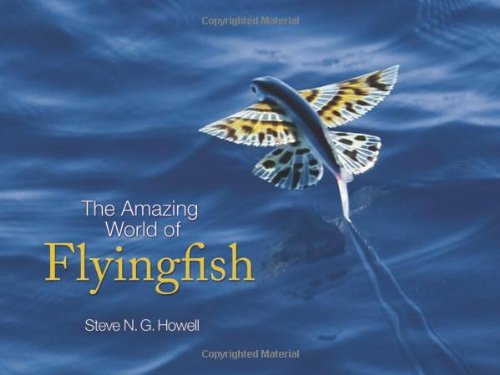Published in the Ocean Watch column, Honolulu Star-Advertiser © Susan Scott
August 11, 2014
Two weeks ago Craig and I, with about 40 others, attended our friends’ wedding. We got ready for the ceremony and reception by dressing in shorts and slippers, donning hats and applying sunscreen. The event took place on a boat.
As we left Kewalo Basin, white terns hovered ahead, and off Waikiki a school of black durgons surrounded the catamaran like a party of best men in blue-edged tuxedos. But the animals that caused the group to gasp were marvelous creatures that straddle the worlds of air and ocean: flyingfish, known in Hawaii as malolo.
Lots of marine animals jump from the water into the air. Flyingfish are the only ones that can stay there.
But not for long.
Glides average 10 to 30 seconds, with occasional exceptions. In 2008 a Japanese ferry rider filmed a flyingfish gliding for 45 seconds, the longest airborne time recorded.
Baby flyingfish, called smurfs, look so different from adults that over the years people named about 150 species. Today researchers agree that the worldwide number is between 60 and 70.
The longest grow to 20 inches, but most are between 6 and 12 inches.
The flyingfish family name, Exocoetidae, comes from a Latin word meaning “sleeping outside,” a label resulting from ancient sailors’ belief that flyingfish came ashore at night to sleep.
They don’t, of course, but if fish could wish, this might be high on their list. Just about every predator in the ocean eats flyingfish day and night.
And their glides over water at 30-some mph for up to 300 feet don’t guarantee a getaway. When flying fish leap from tunas below, they’re meals for seabirds above.
Without a boat, flyingfish are nearly impossible to see, and even from a boat, their speed and size make it difficult to determine colors, patterns and behaviors.
Now, though, we can all see the fantastic fish in vivid detail. For years, author, photographer and bird tour leader Steve N.G. Howell captured flying fish on camera, and shares his stunning photos in a new book called “The Amazing World of Flyingfish” (Princeton University Press, $12.95, 64 pages).
The photos show colorful wings in exquisite patterns. These are reflected in the informal names Howell and friends call the fish: Big Raspberry, Violaceous Rainmaker, Black-eyed Blushwing, Ornate Goldwing and Purple Haze, among others. Howell also includes hard-to-find flyingfish facts.
The close-up pictures of fish gliding and seabirds catching them, as well as the compiled information, are exceptional.
As the wedding catamaran sailed along the Honolulu shoreline, the sparkling school of turquoise malolo bursting from below was such an elegant performance, it brought tears to my eyes.
As did the marriage vows. How privileged I felt to be on a boat surrounded by exquisite marine creatures, off the world’s most beautiful city, in a state where everyone in love and committed to one another can get married.
Congratulations, John and Ed. Your special day was special for us all.